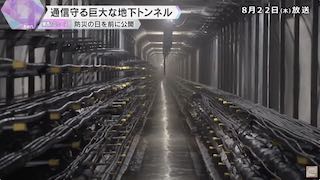KYOTO, Aug 23 (News On Japan) - In anticipation of 'Disaster Prevention Day' on September 1, a massive underground tunnel designed to protect communication cables from disasters was unveiled to the media on August 22.

Reporter Anna Yamaguchi: "This tunnel, located deep beneath Osaka, actually connects Kyoto to Kobe."
The tunnel, known as a "tōdō" (communication tunnel), was constructed by NTT West about 60 years ago. It serves to safeguard communication cables from potential disasters and was specially opened to the public ahead of Disaster Prevention Day.
Inside the tunnel, approximately 18 million communication cables for internet and telephone services are intricately laid out, stretching from Kyoto to Kobe like a maze.
The tunnel is also equipped with disaster-prevention facilities such as fire doors and drainage pumps, and it reportedly withstood the Great Hanshin-Awaji Earthquake without sustaining any damage.
Source: YOMIURI















